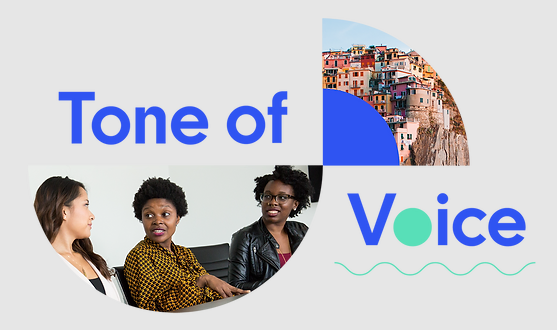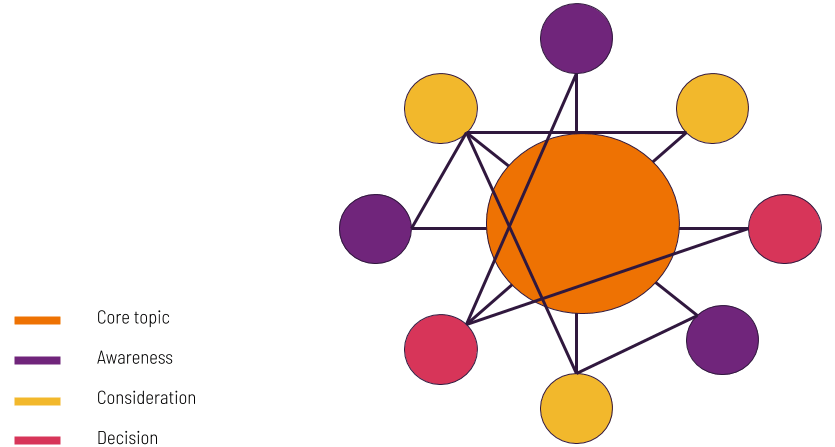Does your company have a distinct voice? A recognizable style that sets you apart from your competition? Or does your web and app copy sound exactly the same as countless other companies? Like other style guidelines, a tone of voice guide is a document where brands can define their personality and express their values and their way of thinking. Even more, it’s a tool to ensure consistency in your writing.
Because of this, a tone of voice guide can’t be created out of thin air. It’s a resource that should document who you are as a company, your values and how to transmit them in your writing. It can be aspirational, but it should be grounded in your current branding.
If you want to start separating yourself from the counbtless other companies out there and let your personality shine, keep reading.
What’s the difference between tone, voice, and style?

Table of Contents
ToggleIt’s important not to confuse a tone of voice guide with a style guide. Both documents are important to define your brand personality and provide consistency to your writing. But all three elements, voice, tone and style, are important and should work together.
- Voice is a description of your brand’s personality. It could be playful, authoritative, straightforward or funny, depending on the brand.
- Tone is how that personality, your brand voice, adapts to specific situations. It works the same as with your voice. It’s always the same, but you use a different tone in a meeting with your boss and reading your kids a story before bedtime. If the voice is about the brand’s personality, the tone is about how that voice can best serve the user’s needs. If they are confused or looking for help, you will use a different tone than if you want them to celebrate achieving a milestone.
- A style guide should contain more straightforward writing guidelines, like how you use capitals, active or passive voice, how to spell certain words related to the core brand, vocabulary. You would usually refer as well to some well-known style guide, like the AP Stylebook, for the most common guidelines.
Why a tone of voice guide is essential for your brand?

A tone of voice guide is a key document to flesh out your brand and provide key guidelines to internal and external writers when writing on behalf of the brand. For example in landing pages, help documents or app microcopy.
There are five key benefits that brands with a tone of voice guide enjoy:
- Writing as one. Writing is often a shared responsibility between different individuals, maybe even different teams. You may be working with freelancers or agencies to develop content for your business. This set of guidelines ensures that no matter who’s doing the writing, your brand personality will come through.
- Consistency. Email newsletters, push notifications, chatbots, websites… Your business likely uses several different channels to reach out to your audience. A tone of voice guide helps you keep the communication across different channels consistent while guiding you on how to adapt your voice to different user contexts.
- Personality. Brands that don’t make the effort to define how their brand sounds in writing often lack any kind of personality. Their content is bland, dull and is quickly forgotten in the torrent of content we consume every day. A brand with a distinct, strong personality will differentiate itself from all the noise in our screens. This personality has an impact on the bottom line too: research from the Harvard Business Review found that customers who fully connected emotionally with brands were 52% more valuable than those who were highly satisfied with no emotional connection.
- Audience engagement. Tone of voice guidelines will help you create content that respects your audience, understands their context, and helps them achieve their objectives.
- Improved editorial processes. Any writer will tell you how having a clear set of guidelines helps them in their process. You’ll need fewer drafts to get content that is perfectly aligned with your brand’s voice.
How can you create a voice of tone guide for your business?

Mailchimp’s public voice and tone guidelines have been an inspiration for many other companies.
For established brands, the most effective tone of voice guides are based on researching and documenting the existing brand voice. For new brands, the document will be more aspirational, as it’ll define what you want your brand to sound like. In both cases, the document provides guidance and a way to measure the content you produce against them.
Research your brand and your audience
A voice of tone guide is more than just a list of adjectives. It’s a reflection of your brand and your company values: how do you want to be perceived and how do you want to interact with your audience. That’s why the first two steps are always to look at who you are as a company and who you want to reach.
The first step is to document your existing brand voice:
- What are your core values? Even if you don’t have branding guidelines you must have some sort of mission statement or document that defines your company’s purpose. You can use that to distill your core values. You can see an example of Zappo’s core values.
- Audit your existing content. This step is key to know what your brand sounds like today. Your audit should focus on your best and worst-performing content according to web analytics tools. Analyze each content piece and try to describe and categorize the personality communicated by each piece. See if there are any patterns or similarities between the top-performing pieces, and between the worst ones as well. This exercise will ground the decisions taken in the next steps and will help you align your voice with the content that already resonates with your audience. You can’t define your tone of voice without taking into account the most critical element of your communications strategy: the people on the other side of the screen.
- Research your audience. If you don’t know who you’re talking to, then you won’t know how to talk to them. So do your research on your audience. Who they are, what they want and what they need (it’s not necessarily the same!). You can compile all the data you uncover on this research and build actionable user personas.
- Ask them how they see you. You are not your users.Repeat with me: you are not your users. So while your assessment of your current brand voice is valuable, don’t forget to ask your audience how they see you. It doesn’t need to be anything complicated. You can present them a survey with a brief list of adjectives to choose from, and ask them which would best describe your brand personality.
Define your brand’s personality attributes
Now it’s the time to distill all that information into a concrete guide that defines the way to communicate your brand’s personality.
To start to define your brand voice, I find very useful the framework proposed by NNGroup based in four tone of voice dimensions:
- Funny vs Serious: Humor is a powerful tool to make your brand accessible and relatable to your users. But it’s always a risk, as you will have to carefully assess when humour it’s appropriate and when it’s not. Humour doesn’t fit with every company as well. On the other hand, a more serious voice transmits credibility and trust.
- Formal vs Casual: A formal voice can help you build a perception of professionalism and authoritativeness. Casual language is more appropriate for warm and friendly brands that treat their users as their peers.
- Respectful vs Irreverent: Brands with an irreverent personality may come across as confident, but they can also alienate some users if they are not perfectly aligned with their audience. A respectful voice can help you transmit your care for your users.
- Enthusiastic vs Matter-of-fact: An enthusiastic voice can energize and drive your users into action. A more matter-of-fact voice is helpful to convey honesty and simplicity.
Once you have defined your voice across these four dimensions, you can get more granular and refine in more detail what your voice sounds like.
Related: NNGroup also has a helpful list of 37 adjectives that you can use
Content strategist Nicole Fenton and Kate Kiefer Lee, VP of Communications and Corporate Affairs at Mailchimp, suggest in their book Nicely Said,that a helpful exercise is to define your tone of voice adjectives: make a This But Not That list. It’s very easy. You just choose a set of adjectives from that list, or write down your own, and then clarify each one by what it doesn’t mean. They put Mailchimp as an example, by saying that Mailchimp’s voice is confident but not cocky, or expert but not bossy. It’s a great way to explain and add more meaning to each personality trait.
This exercise is best conducted as a workshop, where a discussion about the voice attributes with your stakeholders will help you gain buy-in on the final voice dimensions and attributes. It’ll also enrich your final document with their challenges and contributions.
Examples and tone variations
Example of tone applications of a company’s voice. Source: GatherContent
Now that you have defined your brand voice, it’s time to find examples of the different tones you are most likely to use on your communications. Ideally, you should provide as many examples as possible, not just on what to do, but on what to avoid as well. This helps other writers get a better grasp of the voice personality traits and eliminates the subjectivity when interpreting them. There are two ways to structure these examples:
- Provide both a positive and negative example of a piece of content. It could be an error message, a shopping notification, a headline, or a tweet. Then explain concisely why one example works better than the other.
- Another approach suggested in this article is to provide three examples: one that applies a voice personality trait too much, another that applies it too little, and a third example that it’s just right.
When providing tone variations it’s useful to explain how the tone adapts to different scenarios (answering a support request or celebrating a user milestone, for example). It’s always helpful to anchor the examples and explanations to a user persona, if possible. It’s a friendly reminder about user empathy: you are always writing for someone.
Test and evaluate your brand voice guidelines
Now it’s time to put your guidelines to the test. Prepare some pages and user journeys following the new guidelines and conduct a focus group session with some users to gather their feedback on your voice and tone. You want to know if they can perceive the personality traits you want to transmit and how they affect their perception of the brand.
How to make sure people use your voice of tone guide

What happens after you finish your shiny new tone of voice guide? Surely your writing will now be absolutely outstanding and will reflect your brand personality accurately? Not so fast. You need to make the voice of tone guidelines well-known and accessible to everyone in your company:
- Introduce the tone of voice guide to your writers through a workshop.
- Appoint an editor, someone who for the first few months after the implementation of the tone of voice guide can review the main pieces of content you publish and make sure they are following the guidelines.
- Make it part of your onboarding process.
- Have a searchable online version (not necessarily public) easily accessible to your employees.
- Investigate if your CMS or your templates can include certain key elements of the guide as a checklist the writer needs to tick off.
- Monitor usage. If someone is not following your tone of voice guidelines, ask why.
- In some cases, it could help to have copies of the guide printed, bound, and readily available.
It’s important to include some sort of governance process to make sure the document is not created and instantly forgotten. It needs to be constantly updated, reviewed and amended to make sure it continues to reflect your brand personality as it changes and adapts. Dropbox has a great maintenance process for their style guide, which includes not just a volunteer monthly meeting to address feedback, but also a Slack channel and one-minute writing tips on weekly design meetings.
Great examples of tone of voice guides

The best way to appreciate the usefulness of a tone of voice guide is to see one in action. Here are some of the best voice of tone examples out there:
First, of course, Mailchimp. Their style and voice of tone guidelines were one of the first published in the open for everyone to see. “We speak like the experienced and compassionate business partner we wish we’d had way back when. We want to educate people without patronizing or confusing them. Using offbeat humor and a conversational voice, we play with language to bring joy to their work”. In just three short sentences they have perfectly summarized their brand voice.
Airbnb doesn’t have a public document to outline their tone of voice, but their Head of Content Strategy, Marissa Phillips, published a post explaining their process and their voice, which they define as “straightforward, inclusive, thoughtful, and spirited”. They know they can’t be all those things at once in every situation, so the balance between the different personality traits changes depending on the tone they need to adopt.
Buffer’s 404 page is approachable, clear and genuine.
Buffer took the same approach, but in this case, Kevan Lee, VP of Marketing at Buffer, shared whole pages from the guide. “Buffer’s voice is relatable, approachable, genuine, and inclusive. We speak with clarity. We strive for expertise”. Notice how striving for expertise is a completely different attitude as speaking with expertise. One interesting bit about Buffer’s guide is that they hire with voice in mind, meaning that one of the things they look for in candidates is a certain alignment with their company culture, as defined in their voice guidelines.
Finally, Shopify follows the same “this, but not that” pattern we discussed previously. Shopify defines their voice as “confident, not arrogant, empathetic, not overprotective and transparent, not blunt”. Their examples are great to see how they explore tone applications.
Consolidate your brand with tone of voice guidelines

Whether your company is an established business with a secure foothold in your market or if you’re a newcomer hoping to disrupt, having a clear set of guidelines around your brand voice and its applications in different contexts will help you improve the consistency of your communications and consolidate your brand’s personality. A tone of voice guidelines document is a great tool to help you craft a distinct, unique voice that separates yourself from your competition.
Do you have a tone of voice guideline for your business? How do you stand out from the pack? Let us know in the comments below.









